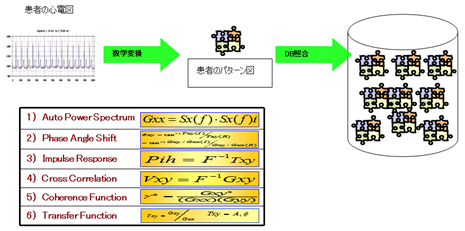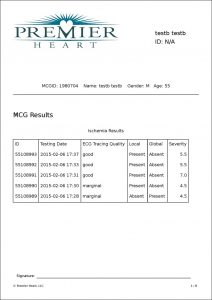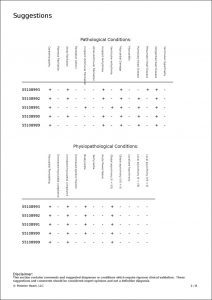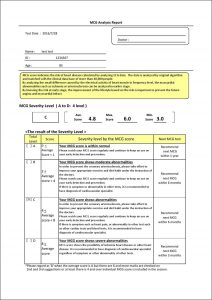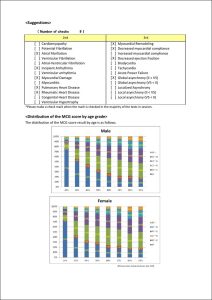Approval as a medical device/MCG technology/Comparison with other devices/How to test/MCG report/Evidences
Approval as a medical device
MCG is a medical device approved by US FDA (510K).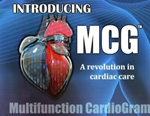
MCG obtain US CPT Code.
The test devices conforming to MCG analysis are certified as medical devices in Japan and Korea. (Toray Medical Co.Ltd is the supplier of medical device in Japan.)
The MCG device is also approved as an medical device in Malaysia.
MCG Technology
MCG is a new analysis technology practically used in medical sites,
by taking advantage of the AI technologies which have not been applied to use for clinical diagnosis so far.
The technology has the following three features -(1)frequency analysis, (2)algorithm by AI, and (3)database matching.
(1)Frequency Analysis
The frequency analysis technology is mainly used in mechanical engineering and acoustic engineering. For example, in non-destructive inspection of tunnels, the abnormality of the structure is inspected by hammering the walls of the tunnel and grasping the difference of the frequeny structures of the sounds of its acoustic echos.
Also, when poultry farmers ship raw eggs to the whole sale markets, their inspecting machine gently hits the eggs and grasp the difference of the frequenycy structures of its acoustic echos of invisible cracks.
MCG is a technology that uses such technology for electrocardiography.
· In addition, frequency-based technology has already been used for biological information such as EMG and electroencephalograph.
(2)Algorithm by AI
The MCG algorithm defines the relations between the characteristics of the frequency level and diseases.
In MCG, we compare differences such as time lag, composition, and relationship between two leads of ECG(V5 and II lead) in frequency level, and hold such characteristics as 166 indexes.
In MCG, we also grasp these differences found in normal and abnormal people,and forming it in algorithm.
Through the researches over the past 30 years, Premier Heart formed the existence and combination of the index for diseases and systematized them as an AI based algorithm.
(3)Database
MCG holds approximately 40,000 clinical database including healthy people and patients with diseases.
The database consists of males and females from 14 years old to 100 years old.
The MCG system matches an ECG acquired from a patient with the database, analyzes the severity of the disease by its AI and reports the results.
Comparison with other deivces
When comparing MCG to the medical devices with high accuracy,
the most valued benefit of MCG is “non-invasive” (not damaging the patient’s body) with high accuracy.
For example, just like MCG, ECG test can be completed without invasion.(The patient only lies on a bed in a few minutes). However, it is said that the accuracy especially for the ischemic heart disease is not high, and hard to find the disease especially for without symptoms.(In some cases ischemic heart disease has no symptom and there is”Acute Coronary Symdrome” – suddenly attacked by chest pain.)
In stress ECG test,(which makes the patient to ride a bicycle during testing,etc.),it causes an increase in the heart rate of the patient,and
then there are possibility that causing anemia or syncope.
Also, some of the patients can not take this test because of joint pain etc.
In CT and scintigraphy, they are high accurate tests, but there is a problem of radiation exposure. Further, for using contrast agent, there is invasion such as injection of a contrast medium. Also, there are some patients with contrast contraindication.
Tests using catheter such as coronary angiography involves invasion such as injection of a contrast medium by injection and passage of a catheter from a wrist or foot vessel.
In this manner, various tests related to the heart disease differ in terms of disease condition, invasiveness, and accuracy.
Among such tests, MCG is the test which is non-invasive and high accuracy examining cardiac muscle cell activity through electricity of the heart.
Information (except MCG data) from: Cleveland Clinic Intensive Cardiology Review Course, 2001.MCG Data from: Premier Heart Clinical Trials.
1 – Percentage of luminal encroachment by atherosclerotic plaque 2 – EST indicates Exercise Stress Testing
3 – Ann. Intern. Med. 2006; 145:407-415 4 – Dependent on internet connection speed 5 – Quantifies stress/strain between the myocardium and blood flow
How to test and Reports
Pictures of MCG Test Steps is here.
Video of Testing Procedure is here.
Video of device software operation is here.
MCG test is very simple.
First of all, the patient should lie down on the bed and put one electrodes on the chest and four electrodes on arms and legs.
Then record ECG 82 seconds, for 3 to 5 times.(Total 5 to 10 minutes)
This is the end of the inspection.
The recorded ECG data is transmitted to the data server located in New York, USA via the Internet.
In the data server, ECG data is converted into a frequency band and broke down to finer level.
Then, such data is compared with the database with 40,000 people (including healthy people and patients), analyzed by 166 indexes by its AI, and the result is reported with a score of 0 to 22 according to the severity of the disease.
Because data is automatically analysed by AI, the analysis is completed in a few minutes and it is possible to use it 24 hours a day, 365 days.
Reports containing analysis results can be viewed and downloaded through the Internet by logging in to Premier Heart’s website.
Doctors can use the report for his/her diagnosis guiding the patients to precise tests, improvement of lifestyle habits, or etc.
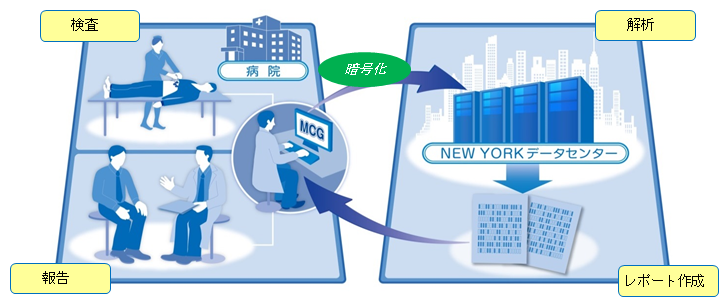
MCG Reports
MCG analysis results are reported as “MCG report”.
The MCG report shows the MCG score of “0 to 22” depending on the severity.
The score 0 is normal, and the higher the score, the higher the severity.
In past clinical trials, score 4 or higher was defined as “abnormal”.
Therefore, it is possible to grasp the condition grade depending on the score.
With this, it is possible to respond to scores, such as how much attention and precise test is necessary, or whether improvement of lifestyle is necessary.(In particular, since MCG detects abnormality from the early stage, it is effective for early detection.)
There are case reports that the score goes down by improving the patient condition. (For example, by improving treatment and lifestyle habits.)
MCG is useful for long-term treatment and improvement status of patients creating the relationship with patients.
[MCG Report]
[MCG Simplified Report for patient]
Evidences
MCG is supported by the evidences of clinical trials conducted in various countries around the world.
In 2001, a clinical trial was conducted in USA, Germany, Japan, Korea, Singapore and India, comparing MCG test results with the result of coronary angiography of 70% or more stenosis.
This is a double blind test on 1,076 people, and the sensitivity was 91.2% and the specificity was 84.6%.
In this trial, the MCG result was not affected by the factors such as age, gender, race, nationality, presence or absence of history of PCI, forms of ECG, or the diagnostic performance in the medical centers participated in this trial.
After this trial, researches were conducted mainly in Japan. Such researches were presented in Japan Society of Cardiology (2014), the Japanese Society of Human Dog (2015, 2016, 2017), and the Japan Cardiovascular Society (2016, 2017), etc.
Further, MCG researches were published and evaluated as “effective for early detection” in international peer review journals such as the British Cardiovascular Society journal “OpenHeart” (2014) and Journals of American Society of Cardiovascular Society “CCI” (2015), etc.
For more clinical researches and studies, pleaes click here.

(*1) Amano T, Shinoda N, Kunimura A, et al. Open Heart 2014;1:e000144. doi:10.1136/openhrt-2014-000144
(*2) Grube E, Bootsveld A, et al. Circulation. 2007;116:II_367
(*3) Strobeck J, Mangieri A,” Paired-comparison of the resting multifunction cardiogram (MCG) with stress sestamibi SPECT myocardial perfusion imaging in the detection of relevant coronary stenosis (>70%)” ACC,11 60th Annual Scientific Session, 2007
(*4) Canali G, et al. “Non Invasive assessment of relevant coronary occlusion through mathematical analysis of spectral ECG Components (MCG) with comparison with coronary angiography in Symptomatic Patients” ESC Congress 2012
(*5) Masahiro Takeshita, Norihiro Shinoda, et al. Catheterization and Cardiovascular Interventions DOI 10.1002/ccd.25924
(*6) Kadotani M, et al. “Comparison of a two-Lead, computerized, resting ECG signal analysis device, the Multifunction-CardioGram (MCG), to coronary angiography or MDCT,
SPECT for the detection of relevant coronary artery stenosis” TCTAP 2015, South Korea

